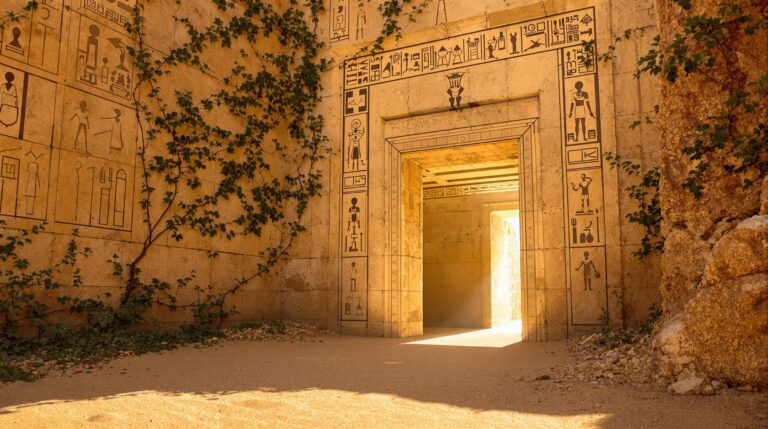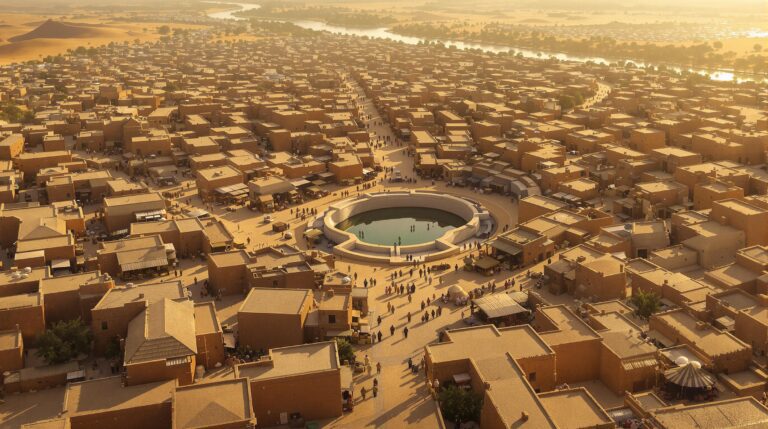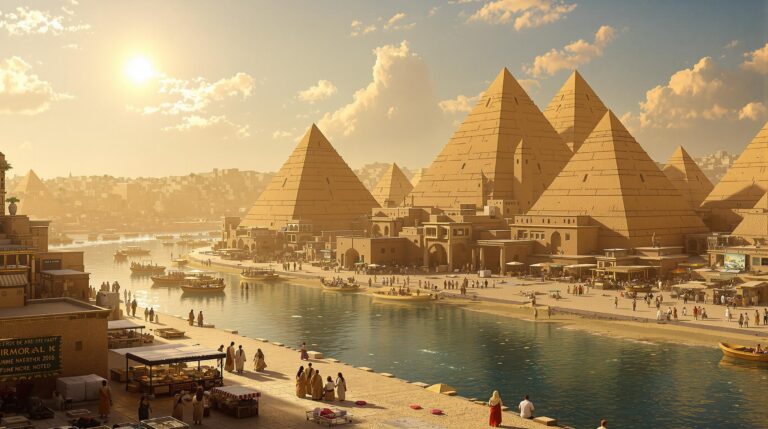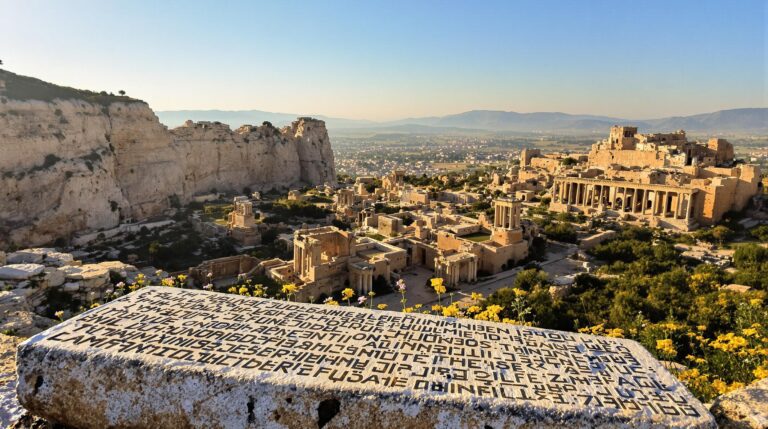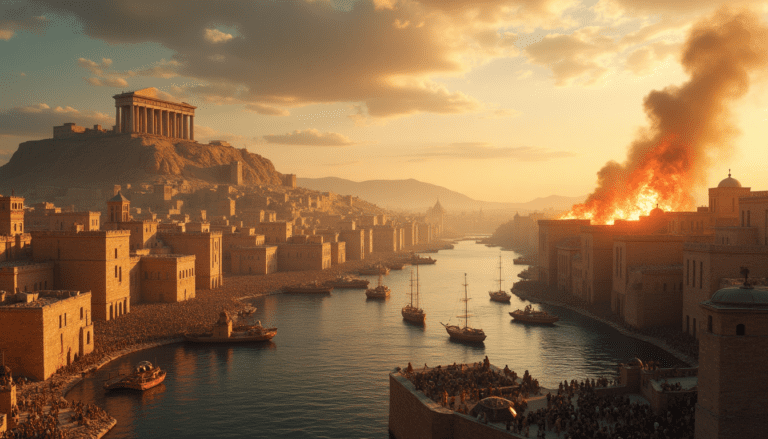Minoan Civilization: Art, Trade, and Eruption
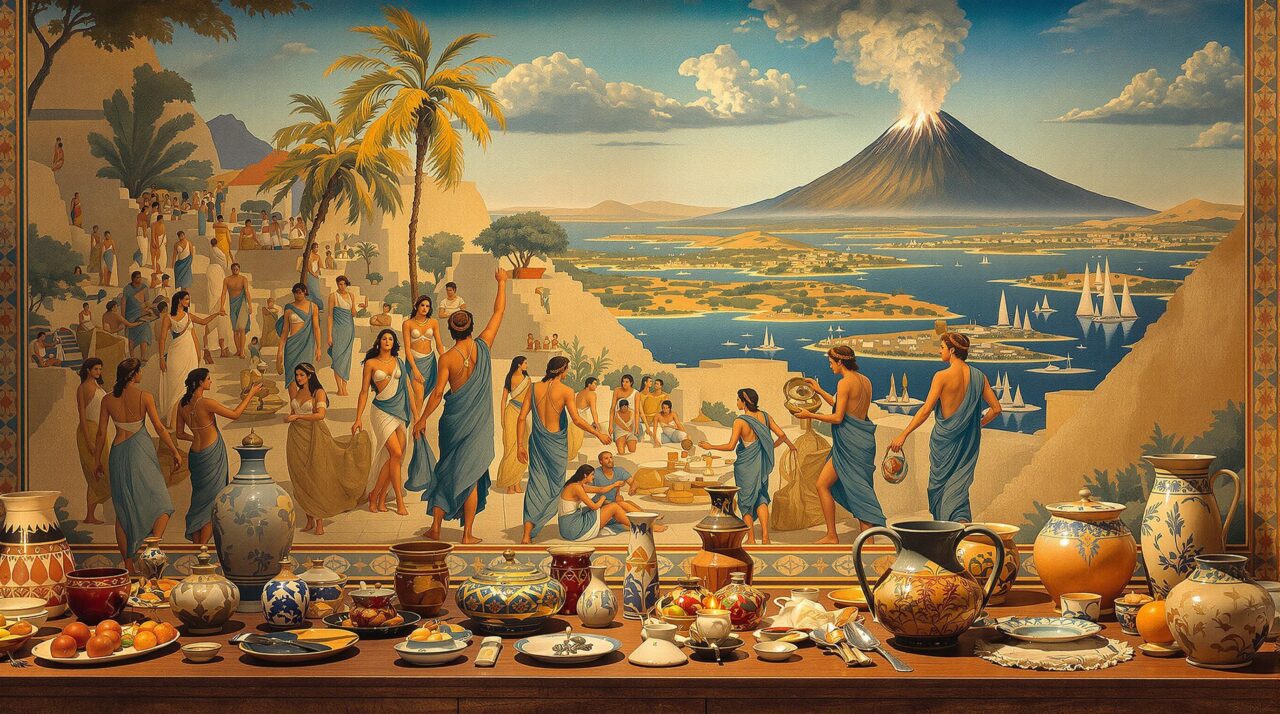
The Minoan civilization represents a fascinating intersection of art, trade, and environmental challenges.
Their sophisticated palatial centers and intricate frescoes reveal an advanced society deeply intertwined with nature and spirituality.
However, the catastrophic eruption of Thera profoundly impacted their trajectory.
This raises questions about the resilience of cultural identity amid disaster. How did such upheaval reshape Minoan influence in the Aegean and beyond? The answers may illuminate the broader patterns of civilization itself.
Highlights
Hide- Minoan art, particularly frescoes, reflects a strong connection to nature, religious practices, and societal values, showcasing advanced craftsmanship.
- Extensive maritime trade networks linked Crete to various regions, enhancing Minoan economic power through the import and export of goods.
- The eruption of Thera around 1600 BCE caused significant environmental and socio-economic disruptions, contributing to the Minoan civilization's decline.
- Minoan architecture, especially at Knossos, illustrates sophisticated urban planning and reflects cultural identity through shared design elements and communal spaces.
- The Mycenaean incursion marked a cultural shift in the Aegean, reshaping Minoan influences in subsequent civilizations, particularly in architecture and religion.
Origins and Location of the Minoans
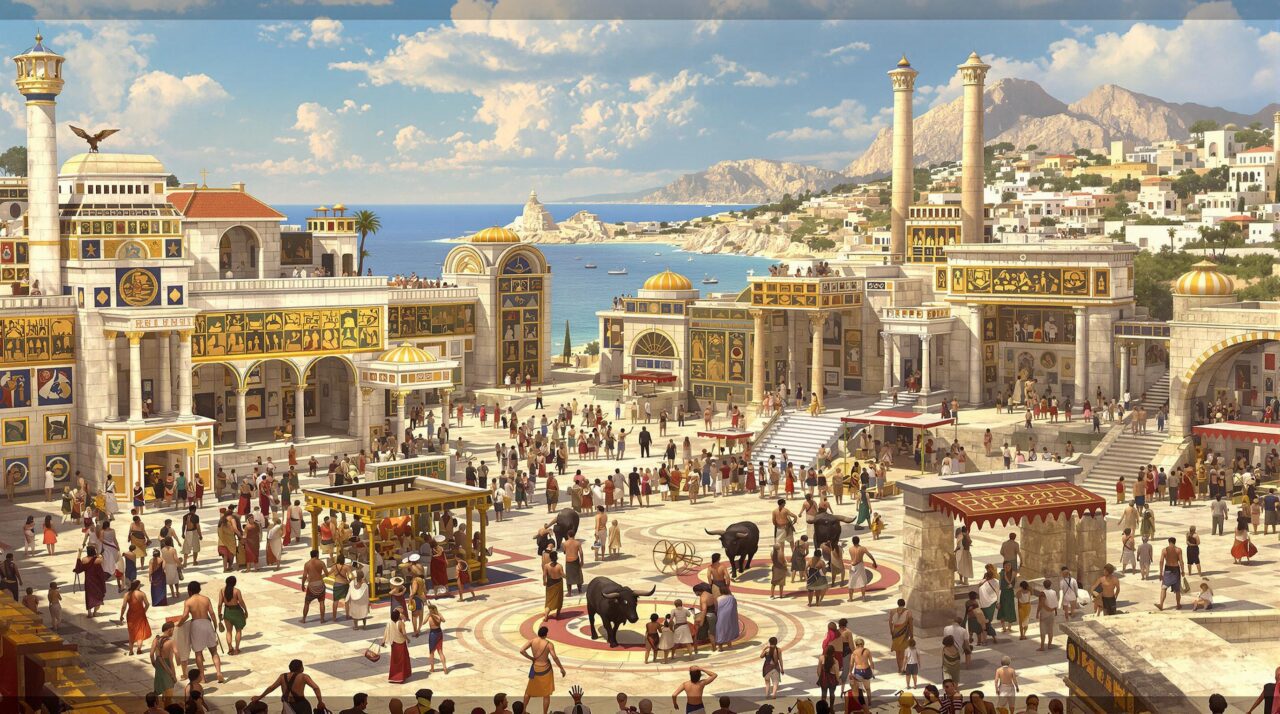
The origins and location of the Minoans are pivotal to understanding their civilization’s influence in the ancient world.
Situated on the island of Crete, this strategic hub facilitated trade and cultural exchange across the Mediterranean, fostering an environment ripe for early settlement and development.
Analyzing the interplay between geography and cultural evolution reveals how Crete became a cradle for Minoan innovation and societal complexity.
The Island of Crete and Its Strategic Importance
The island of Crete, with its natural harbors, offered unparalleled opportunities for maritime trade, positioning the Minoans as key players in the Aegean economy.
This strategic location not only facilitated commerce but also fostered a unique environment for cultural and technological innovation, largely insulated from mainland influences.
Consequently, Crete’s geography played a pivotal role in shaping the distinct identity and advancements of Minoan civilization.
Natural Harbors and Maritime Trade Potential
Although often overshadowed by their monumental palaces and intricate frescoes, the natural harbors of Crete played a pivotal role in shaping the Minoan civilization’s maritime trade potential.
These sheltered ports facilitated the exchange of goods, ideas, and cultures, establishing Crete as a nexus of commerce. The strategic location allowed the Minoans to thrive, fostering economic prosperity and regional influence across the Aegean.
Isolation and Innovation in the Aegean Sea
While many ancient civilizations were influenced by neighboring cultures, the Minoans of Crete developed in relative isolation, which fostered a unique environment for innovation.
This seclusion allowed them to cultivate distinct artistic styles and technological advancements, reflecting their independence.
The strategic location of Crete, combined with its natural resources, further empowered the Minoans to thrive, shaping a civilization that was both original and resilient.
Early Settlement and Cultural Development
The Minoans emerged from Neolithic agricultural roots, gradually evolving into a complex urban society marked by sophisticated developments in trade and culture.
Influences from neighboring civilizations, such as the Egyptians and Near Eastern cultures, played a pivotal role in shaping Minoan identity during its formative years.
This intricate interplay of local innovation and external impact set the stage for a distinctive civilization that would leave a lasting legacy in the ancient world.
Neolithic Roots and Transition to Urban Society
Emerging from the fertile landscapes of the Aegean, the Minoan civilization traces its origins to the Neolithic period, a time characterized by transformative agricultural practices and the gradual change from nomadic lifestyles to settled communities.
This shift laid the foundation for complex social structures, fostering innovation in craft and trade, ultimately leading to the rise of urban centers that defined Minoan identity.
Influence of Neighboring Cultures in Early Periods
As the Minoans established themselves on the island of Crete, their cultural development was greatly shaped by interactions with neighboring civilizations, such as the Egyptians and the Mesopotamians.
These influences fostered a unique identity characterized by:
- Artistic innovation and symbolism
- Advanced trade networks and economic prosperity
- Architectural marvels that echoed the grandeur of their counterparts
Through these exchanges, the Minoans carved their legacy in history.
Palatial Centers and Urban Planning
The palatial centers of the Minoan civilization, particularly Knossos, stand as monumental symbols of their architectural sophistication and social organization.
Alongside Knossos, the sites of Phaistos, Malia, and Zakros reveal a network of urban planning that reflects both political power and economic activity.
This interconnectedness not only illustrates Minoan ingenuity but also prompts further exploration of their influence on subsequent Aegean cultures.
Knossos: The Largest and Most Influential Site
Knossos stands as a demonstration of Minoan architectural ingenuity, showcasing complex storage systems and multifaceted religious spaces that reflect the civilization’s sophisticated urban planning.
The site not only served as a political and economic hub but also inspired legendary narratives, such as the labyrinth myth associated with King Minos, intertwining architecture with cultural storytelling.
Analyzing Knossos reveals how its physical structure and mythological significance shaped Minoan identity and influence throughout the ancient world.
Architecture, Storage Complexes, and Religious Spaces
Minoan architecture, epitomized by the grand palatial centers at Knossos, reveals a sophisticated interplay between functionality and aesthetics that defined urban planning on the island of Crete.
This architectural marvel encapsulates:
- The intricate storage complexes, safeguarding precious resources.
- Sacred religious spaces, fostering spiritual connection.
- Expansive communal areas, promoting social cohesion.
Together, these elements illustrate a civilization deeply attuned to both practicality and cultural expression.
The Role of the Labyrinth Myth and King Minos Legend
Intriguingly, the architectural complexities of Knossos extend beyond mere functionality, intertwining with the intricate fabric of myth and legend that characterized Minoan culture.
The legend of King Minos and the labyrinth symbolizes not only authority and order but also the enigmatic nature of human existence. This narrative reflects Minoan values, showcasing the interplay of architecture, power, and the collective psyche of a civilization seeking for meaning.
Other Key Palaces: Phaistos, Malia, and Zakros
The palatial centers of Phaistos, Malia, and Zakros offer a fascinating glimpse into the regional variations and commonalities within Minoan architecture.
Each site features distinct characteristics while sharing critical design elements such as central courtyards, light wells, and advanced drainage systems, reflecting both functional and aesthetic priorities.
Analyzing these similarities and differences can provide deeper insights into the urban planning strategies and societal organization of the Minoans.
Regional Differences and Shared Design Features
While exploring the palatial centers of Phaistos, Malia, and Zakros, it becomes clear that regional differences and shared design features highlight the complexity of Minoan urban planning.
- Distinct architectural styles reflect local resources and cultural identities.
- Innovations in layout promote communal interactions.
- Artistic motifs reveal a shared spiritual connection among diverse communities.
These elements intertwine, showcasing a civilization that valued both individuality and unity.
Central Courtyards, Light Wells, and Drainage Systems
Central courtyards, light wells, and sophisticated drainage systems exemplify the advanced urban planning of Minoan palatial centers such as Phaistos, Malia, and Zakros.
These architectural features not only facilitated natural light and ventilation but also showcased a deep understanding of water management.
Such innovations reflect a society that valued aesthetics and functionality, fostering communal spaces while ensuring public health and environmental sustainability.
Art, Craftsmanship, and Writing
The artistic expressions of the Minoan civilization reveal a sophisticated culture that embraced visual storytelling through lively frescoes and intricate pottery.
Their craftsmanship extended to metalwork and luxury items, highlighting a society that valued both utility and beauty.
However, the enigmatic nature of Minoan scripts adds a layer of intrigue, leaving scholars to ponder the complexities of their communication and written expression.
Frescoes and Visual Storytelling
Minoan frescoes serve as a vivid narrative canvas, intricately illustrating the civilization’s deep connection to nature, ceremonial practices, and marine life.
The techniques employed in these artworks, characterized by lively color palettes and dynamic forms, reveal not only artistic mastery but also cultural symbolism that reflects Minoan values and beliefs.
Through the lens of visual storytelling, these frescoes provide a window into the intricate fabric of Minoan life, inviting further exploration of their significance.
Depictions of Nature, Ceremonial Life, and Sea Creatures
Artistic expressions in the Minoan civilization reveal a profound connection to nature, ceremonial life, and the surrounding marine environment.
Through lively depictions, they invite contemplation on:
- The delicate balance between humanity and nature.
- The rituals that bind communities together.
- The awe-inspiring beauty of oceanic life.
These themes resonate deeply, suggesting a society that revered the world around them while seeking harmony and freedom.
Techniques, Color Use, and Cultural Symbolism
Frescoes from the Minoan civilization demonstrate a sophisticated mastery of techniques that encapsulate the essence of their culture.
Vivid colors, such as deep reds and oceanic blues, not only enhance visual appeal but also symbolize liveliness and connection to nature.
The fluidity of forms and dynamic compositions reflect a society that embraced freedom, celebrating both the natural world and the spiritual narratives inherent in their art.
Pottery, Metalwork, and Luxury Items
The intricate craftsmanship of Minoan pottery and metalwork reveals not only aesthetic sensibilities but also the societal values of the civilization.
Kamares Ware and Marine-Style ceramics exemplify the Minoans’ connection to their environment and their mastery of decorative arts, while their gold jewelry and tools of trade highlight the importance of commerce and social status.
Through these luxury items, one can glimpse the complexities of Minoan life and the significance of art as a reflection of cultural identity.
Kamares Ware and Marine-Style Ceramics
While exploring the intricate world of Minoan ceramics, Kamares Ware and Marine-Style ceramics emerge as two distinct yet interconnected expressions of artistry that reflect the civilization’s cultural values and technological advancements.
- Vivid colors that evoke the vibrancy of life.
- Flowing marine motifs symbolizing freedom and exploration.
- Intricate craftsmanship showcasing the mastery of artisans.
These elements reveal a society deeply in tune with nature and creativity.
Gold Jewelry and Tools of Trade
Minoan civilization’s artistic expression is not confined to its ceramics; it also finds remarkable representation in gold jewelry and tools of trade.
The intricate craftsmanship of gold artifacts reflects both aesthetic sensibility and societal status, while tools signify advanced trade networks.
Together, they illustrate a culture that valued beauty and functionality, revealing insights into their economic and social structures, and offering a glimpse into their world.
The Mystery of Minoan Scripts
The enigmatic scripts of the Minoan civilization, particularly Linear A, present an intriguing puzzle, as their language remains undeciphered despite extensive scholarly efforts.
This raises questions about the potential connections between Linear A and the later Linear B script, which was definitively linked to the Mycenaean Greeks.
Understanding these relationships could illuminate not only Minoan linguistic practices but also broader cultural exchanges in the ancient Mediterranean.
Linear A and Its Undeciphered Language
Linear A represents one of the most intriguing aspects of Minoan civilization, encapsulating the enigmatic nature of its writing system and the culture that developed it.
The script remains undeciphered, provoking curiosity and speculation about its meaning.
- The allure of lost knowledge.
- The frustration of unbroken codes.
- The yearning to connect with ancient voices.
Relationship Between Linear A and Linear B
Understanding the intricacies of Minoan civilization requires examining the relationship between Linear A and Linear B, two scripts that encapsulate the complexities of ancient writing.
Linear A remains undeciphered, while Linear B, linked to Mycenaean Greek, reveals administrative practices.
This connection suggests a cultural evolution where Linear B adapted elements from Linear A, reflecting the dynamic interplay of language and identity within Minoan society.
Religion and Social Beliefs
The Minoan civilization‘s religious framework reveals a profound reverence for nature, as evidenced by their worship of natural elements and the use of sacred symbols.
Ceremonial practices and public rituals played a pivotal role in their society, serving as communal expressions of devotion that reinforced social cohesion.
Analyzing these elements offers insights into how spirituality intertwined with daily life and governance in Minoan culture.
Nature Worship and Sacred Symbols
The Minoan civilization is marked by a vibrant mosaic of nature worship, reflected in symbols such as the Snake Goddess and the Double Axe.
These sacred icons, alongside the prominence of mountaintop sanctuaries and sacred caves, underscore the society’s deep reverence for the natural world and its spiritual significance.
Analyzing these elements reveals how religious practices intertwined with social beliefs, shaping the Minoans’ understanding of their environment and their place within it.
The Snake Goddess and the Double Axe
Symbolism plays a pivotal role in the religious practices and social beliefs of the Minoan civilization, particularly as expressed through the iconic representations of the Snake Goddess and the Double Axe.
These symbols evoke powerful emotions and connections:
- Feminine power: The Snake Goddess embodies fertility and protection.
- Duality: The Double Axe signifies balance between life and death.
- Nature’s reverence: Both symbols reflect a profound respect for the natural world.
Mountaintop Sanctuaries and Sacred Caves
While exploring the spiritual landscape of the Minoan civilization, one encounters the profound significance of mountaintop sanctuaries and sacred caves, which served as essential sites for religious worship and nature veneration.
These elevated spaces symbolized a connection between the divine and the earthly, embodying Minoans’ reverence for natural forces.
The sanctuaries reflected their communal beliefs, fostering a sense of identity and transcendent experience.
Ceremonial Practices and Public Rituals
Ceremonial practices and public rituals in Minoan civilization reveal a vibrant mosaic of religious expression and social hierarchy.
The dramatic act of bull-leaping, alongside the intricate processional art that adorned their sacred spaces, underscores the significance of these rituals in reinforcing communal identity and spiritual beliefs.
In addition, the prominent roles of priestesses and religious officials suggest a complex interplay between gender and authority within Minoan society, inviting deeper exploration of how these dynamics shaped their cultural landscape.
Bull-Leaping and Processional Art
The practice of bull-leaping in Minoan civilization serves as a vivid illustration of the intertwining of religious beliefs and social dynamics.
This ceremonial act symbolizes both courage and reverence, fostering a unique cultural identity.
Key elements include:
- The exhilaration of defying danger.
- The communal celebration of strength and energy.
- The spiritual connection with the divine, enhancing societal bonds.
Role of Priestesses and Religious Officials
Priestesses and religious officials in Minoan civilization played a pivotal role in shaping both the spiritual landscape and the social fabric of their communities.
They conducted rituals, facilitated communication with deities, and maintained the cultural ethos. Their influence extended beyond religious practices, fostering social cohesion and reinforcing hierarchies.
This intertwining of spirituality and governance reflects the complex dynamics of Minoan society and its reverence for the divine.
Economic Power and Trade Networks
The Minoan civilization emerged as a formidable economic power, primarily through its extensive maritime trade networks that connected various cultures across the Mediterranean.
This trade was underpinned by the agricultural wealth of the region and was further enhanced by innovative technologies that facilitated both production and exchange.
Maritime Trade Across the Mediterranean
The Minoan civilization established a complex network of maritime trade routes connecting Crete to key regions such as Egypt, Anatolia, and the Levant.
This strategic positioning allowed for the importation of valuable materials, while simultaneously facilitating the export of Minoan goods, thereby enhancing their economic power.
The interplay of these trade relationships not only enriched the Minoans but also played an essential role in the cultural exchanges that shaped the Mediterranean world.
Routes to Egypt, Anatolia, and the Levant
Although often overshadowed by its monumental palaces and intricate art, the Minoan civilization‘s economic prowess was profoundly shaped by its strategic maritime trade routes to Egypt, Anatolia, and the Levant.
These connections fostered:
- Cultural exchange that transcended borders.
- Opportunities for wealth and prosperity.
- A legacy of innovation that inspired generations.
Such dynamics reveal the Minoans’ influential role in the ancient Mediterranean world.
Imported Materials and Exported Goods
A diverse array of imported materials and exported goods underscored the Minoan civilization’s economic power and trade networks throughout the Mediterranean.
Precious metals, textiles, and ceramics flowed into Crete, enhancing its cultural richness. In return, Minoans exported fine pottery and olive oil, establishing a lively exchange.
This interconnectedness not only bolstered their economy but also forged lasting relationships across ancient maritime societies.
Agricultural Wealth and Technological Innovation
The Minoan civilization’s agricultural wealth was intricately linked to its innovative techniques, such as terrace farming and sophisticated irrigation practices, which maximized crop yields in a challenging landscape.
In addition, the establishment of storage facilities facilitated efficient food redistribution, underscoring the civilization’s advanced understanding of resource management and economic organization.
Together, these elements not only supported local sustenance but also enhanced the Minoans’ trade networks, reinforcing their status as a significant economic power in the ancient Mediterranean.
Terrace Farming and Irrigation Practices
While the rugged terrain of Crete presented significant agricultural challenges, Minoans adeptly transformed these obstacles into opportunities through innovative terrace farming and advanced irrigation practices.
This ingenuity fostered economic resilience and agricultural abundance, enabling the civilization to flourish.
- Surpassing natural limits.
- Cultivating fertile hope.
- Nurturing communal prosperity.
These practices not only sustained the Minoans but also enriched their trade networks.
Storage Facilities and Food Redistribution
Extensive storage facilities and sophisticated food redistribution systems played an essential role in the economic power of the Minoan civilization, facilitating both agricultural wealth and robust trade networks.
Society and Daily Life
The Minoan civilization presents a complex tapestry of social hierarchy and gender dynamics that shaped daily life on the island of Crete.
Analysis of their clothing, cuisine, and domestic spaces reveals not only the aesthetic values of the society but also the underlying cultural and social structures.
Social Hierarchy and Gender Dynamics
The Minoan civilization exhibits a complex social hierarchy, evidenced by archaeological findings that suggest distinct class structures within their society.
Particularly, the role of women in both public and religious spheres appears to be more prominent than in many contemporary cultures, challenging traditional notions of gender dynamics in ancient societies.
This interplay between social stratification and gender roles invites further examination of how power and status were negotiated and expressed in Minoan daily life.
Evidence for Social Class Structure
Social stratification within the Minoan civilization reveals a complex tapestry of power and privilege that underscores daily life and societal dynamics.
The evidence for social class structure is illustrated through:
- Intricate frescoes depicting elite lifestyles, highlighting wealth disparity.
- Unearthed artifacts, suggesting specialized roles and economic divisions.
- Architectural differences in residences, reflecting status and influence.
These elements invite contemplation on the nature of power and freedom in society.
The Status of Women in Public and Religious Life
Within the Minoan civilization, the status of women in public and religious life presents a fascinating contrast to prevailing narratives of ancient societies.
Evidence suggests that women held significant roles, participating in rituals and possibly even governance.
Artistic depictions further imply their prominence in society, challenging traditional gender dynamics.
This elevated status invites a reevaluation of women’s influence and agency in Minoan culture.
Clothing, Cuisine, and Domestic Spaces
In examining the daily life of the Minoans, one can observe how their clothing and hairstyles reflected not only social status but also aesthetic values.
Their diet, characterized by a variety of fresh ingredients and elaborate food preparation techniques, underscores the importance of communal meals and banquet culture in fostering social cohesion.
The arrangement and design of domestic spaces further reveal insights into their societal structure and cultural practices, highlighting the interplay between environment and lifestyle.
Typical Minoan Attire and Hairstyles
Minoan attire and hairstyles reflect a complex mosaic of cultural identity and social hierarchy in the ancient society of Crete. The bright colors and intricate designs embodied personal expression, while styles varied by status and occasion.
- Flowing robes adorned with bright patterns
- Elaborate hairstyles styled with decorative pins
- Symbolic jewelry indicating wealth and influence
These elements tell a story of individuality and societal roles.
Diet, Food Preparation, and Banquet Culture
While the Minoans are often celebrated for their lively artistry and architecture, their diet and culinary practices reveal equally significant aspects of their society.
Emphasizing agriculture and trade, Minoans enjoyed diverse foods, including grains, fruits, and fish.
Banquets served as social gatherings, reinforcing communal bonds and cultural identity, thereby elevating food preparation from mere sustenance to an expression of societal values and shared experiences.
The Fall of the Minoan Civilization
The decline of the Minoan civilization can be attributed to a confluence of catastrophic events and external pressures.
The eruption of Thera likely triggered both environmental and socio-economic upheaval, while the subsequent Mycenaean incursion marked a significant cultural change in the region.
These factors together paint a complex picture of a society in flux, facing challenges that ultimately led to its downfall.
The Impact of the Thera Eruption
The Thera eruption stands as a pivotal moment in Minoan history, marked by geological evidence that suggests widespread destruction across the region.
This cataclysm not only reshaped the physical landscape but also appears to have contributed considerably to the decline of palatial centers, undermining the socio-political structures of the civilization.
Analyzing the aftermath of this eruption reveals the complex interplay between natural disasters and human resilience, prompting deeper inquiries into the eventual fall of the Minoan civilization.
Geological Evidence and Widespread Destruction
Although the Minoan Civilization thrived on the island of Crete, its eventual decline can be closely linked to geological upheaval, particularly the cataclysmic eruption of Thera around 1600 BCE.
This event left behind:
- Ash-covered landscapes, burying thriving cities.
- Tsunamis that ravaged coastal settlements.
- Psychological trauma, disrupting the societal fabric.
These factors collectively marked a turning point, leading to Minoan disintegration and loss of cultural identity.
Links to the Decline of Palatial Centers
As the Minoan Civilization faced the catastrophic aftermath of the Thera eruption, the impact on palatial centers became increasingly evident.
The disruption of trade routes, loss of agricultural productivity, and social upheaval weakened these political hubs.
Consequently, the decline of centralized power marked a shift towards decentralization, highlighting the vulnerability of even the most sophisticated societies to natural disasters and their far-reaching consequences.
Mycenaean Takeover and Cultural Shift
The Mycenaean takeover marked a pivotal change in the Aegean, where the infiltration of Mycenaean culture began to overshadow Minoan traditions.
This shift not only led to the end of Minoan independence but also facilitated the replacement of their distinctive script with Linear B, symbolizing a broader cultural assimilation.
Understanding this transformation reveals the complexities of power dynamics and cultural exchange in ancient civilizations.
Infiltration and Integration of Mycenaean Influence
While the Minoan civilization flourished on the island of Crete, its eventual decline was considerably influenced by the encroachment of Mycenaean culture.
This infiltration reshaped Minoan society, leading to:
- The erosion of unique artistic expressions.
- The subjugation of local governance and traditions.
- The blending of religious practices, unsettling spiritual foundations.
These shifts signified a profound cultural transformation, challenging Minoan autonomy and identity.
End of Minoan Independence and Script Replacement
Minoan independence came to an abrupt end as Mycenaean influence permeated the island of Crete, marking a significant cultural and political change.
The Mycenaeans not only conquered but also imposed their script, Linear B, replacing the Minoan hieroglyphs.
This shift symbolized the erasure of Minoan identity, leading to a homogenized culture under Mycenaean dominance, ultimately stifling the island’s once-thriving autonomy and creativity.
Legacy and Rediscovery
The legacy of the Minoan civilization, characterized by its advanced architecture and intricate artistry, is epitomized by the archaeological discoveries at Knossos and surrounding sites.
These findings not only illuminate the cultural innovations of the Minoans but also reveal their profound influence on subsequent Greek and Mediterranean societies.
As scholars continue to explore the remnants of this ancient culture, the intricate web of connections between Minoan achievements and later traditions prompts a reevaluation of the region’s historical narrative.
Archaeological Work at Knossos and Beyond
The archaeological work at Knossos, primarily led by Sir Arthur Evans in the early 20th century, has sparked significant interest and controversy regarding the interpretation of Minoan civilization.
Evans’ reconstructions, while groundbreaking, have been criticized for their speculative nature, raising questions about their impact on the understanding of Minoan culture.
This legacy of debate continues to influence contemporary archaeological methods and interpretations, highlighting the complexities of reconstructing ancient histories.
Sir Arthur Evans and Early 20th-Century Excavations
While exploring the ancient ruins of Crete, Sir Arthur Evans uncovered a civilization that would reshape the understanding of prehistoric Europe.
His early 20th-century excavations ignited fascination with the Minoans, revealing:
- Intricate frescoes depicting vivid life.
- Advanced architecture showcasing societal complexity.
- Artifacts hinting at extensive trade networks.
These findings not only awakened curiosity but also fostered a deeper appreciation for human creativity and resilience.
Reconstruction Controversies and Interpretation Debates
Although Sir Arthur Evans’s reconstructions at Knossos brought the Minoan civilization into the modern imagination, they also sparked a series of controversies regarding their accuracy and authenticity.
Critics argue that his imaginative interpretations often overshadowed archaeological integrity, leading to debates over cultural representation.
This ongoing discourse challenges historians and archaeologists to reassess the delicate balance between reconstruction and the preservation of historical truth.
Minoan Influence on Greek and Mediterranean Culture
The Minoan civilization’s architectural innovations and religious practices left an indelible mark on subsequent Greek and Mediterranean cultures, revealing a complex web of influence that shaped their development.
This legacy is echoed in the grandeur of later structures and the thematic elements of worship that permeated ancient societies.
Additionally, the enduring fascination with Minoan aesthetics continues to inspire modern literature and art, highlighting the civilization’s relevance and the lasting power of its creative expressions.
Architectural and Religious Echoes in Later Civilizations
Echoes of Minoan civilization resonate through the architectural and religious frameworks of subsequent cultures in the Mediterranean, illustrating a profound legacy that shaped the development of ancient Greek society and beyond.
This influence manifests in:
- The intricate column styles that inspired Greek temples.
- The reverence for deities rooted in Minoan practices.
- The use of sacred spaces reflecting Minoan urban planning.
Such elements reveal a lasting cultural dialogue.
Enduring Fascination in Modern Literature and Art
Minoan civilization continues to captivate modern artists and writers, serving as a wellspring of inspiration that bridges ancient and contemporary narratives.
Its vivid imagery, intricate symbolism, and themes of trade and exploration resonate in literature and visual art, prompting reflections on identity and cultural legacy.
This enduring fascination invites a reexamination of human experience, forging connections across time and space.
Wrapping Up
The Minoan civilization, with its lively artistic heritage and intricate trade networks, stands as a demonstration of human creativity and resilience.
Yet, the catastrophic eruption of Thera raises a poignant question: how fragile is the tapestry of cultural achievement in the face of nature’s wrath?
While the Minoans ultimately faded, their enduring legacy continues to inspire and inform subsequent generations, reminding us of the indomitable spirit that shapes human history amidst adversity.
